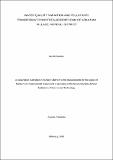Water quality variation and pollutants transformation in the Nadosoito dam of Arkatani village, Monduli district
Abstract
The study aimed at assessing seasonal dynamics of water quality parameters, transformation of selected pollutants and seasonal diversity of selected microorganisms (Cyanobacteria) in Nadosoito dam of Arkatani Village, Monduli district, Arusha Tanzania. The study aimed at establishing the treatability of the dam water using Inclined Plate Settler (IPS) coupled with settling tank and a constructed wetland, from January to September 2017 capturing the wet months and the driest month. Analysis was carried out as per standard methods for the examination of water and wastewater (APHA 2012). High values of COD, from <0.7 to 87 mg/l, and turbidity, from 204 to 53 300 NTU, were recorded. Turbidity and TSS were highest at the onset of rainfall, and generally declined from the wet to the dry season. The highest levels for both were due to loading materials into the dam. Ammonia concentrations ranged from 0.14 to 270 mg/l and nitrate-nitrogen from 0.6 to 1715 mg/l; they were highest towards the end of wet season in april, while NO2-N was highest (290 mg/l) in the dry season (September). There was a notably high value of Phycocyanin (PC) pigment (19.85 to 495 μg/l) unique to cyanobacteria, well above the WHO alert level of 30 μg/l. PC is associated with a variety of toxins affecting humans and animals. Possible sources of pollutants include; animals’ droppings/urine and runoff from farms applying fertilisers. The results of this study suggest that water treatment systems must be designed to take care of the worst influent water quality conditions.

